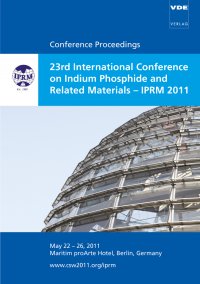Strain Effects on Performances in InAs HEMTs
Conference: IPRM 2011 - 23th International Conference on Indium Phosphide and Related Materials
05/22/2011 - 05/26/2011 at Berlin, Germany
Proceedings: IPRM 2011
Pages: 4Language: englishTyp: PDF
Personal VDE Members are entitled to a 10% discount on this title
Authors:
Machida, F.; Nishino, H.; Sato, J.; Watanabe, H.; Hara, S.; Fujishiro, H. I. (Department of Applied Electronics, Tokyo University of Science, 2641 Yamazaki, Noda, Chiba 278-8510, Japan)
Abstract:
We investigate the effects of the strain on the performances in the nano-scale HEMTs with the InAs and the InAs-related channels. The drain current, Ids, and the intrinsic transconductance, gm0, increase as the In content, x, in the channel increases, which is because of the decrease of the effective mass, m*, in the Γ valley. This indicates the superiority of the InAs channel in terms of the current drivability. In case of the In0.52Al0.48As barrier/buffer, the compressive strain makes m* large in the InAs channel, which leads to the decrease of Ids and gm0. However it makes the impact ionization threshold energy, Eth, large, which leads to the suppression of the impact ionization. In case of the AlSb barrier/buffer, the tensile strain makes m* small in the InAs channel, which leads to the increase of Ids and gm0. However it makes Eth small, which leads to the promotion of the impact ionization. In conclusion, the InAs channel with the AlSb barrier/buffer is preferable for attaining the high current drivability, even though it is restricted within the narrow limits of the low Vds applications.


